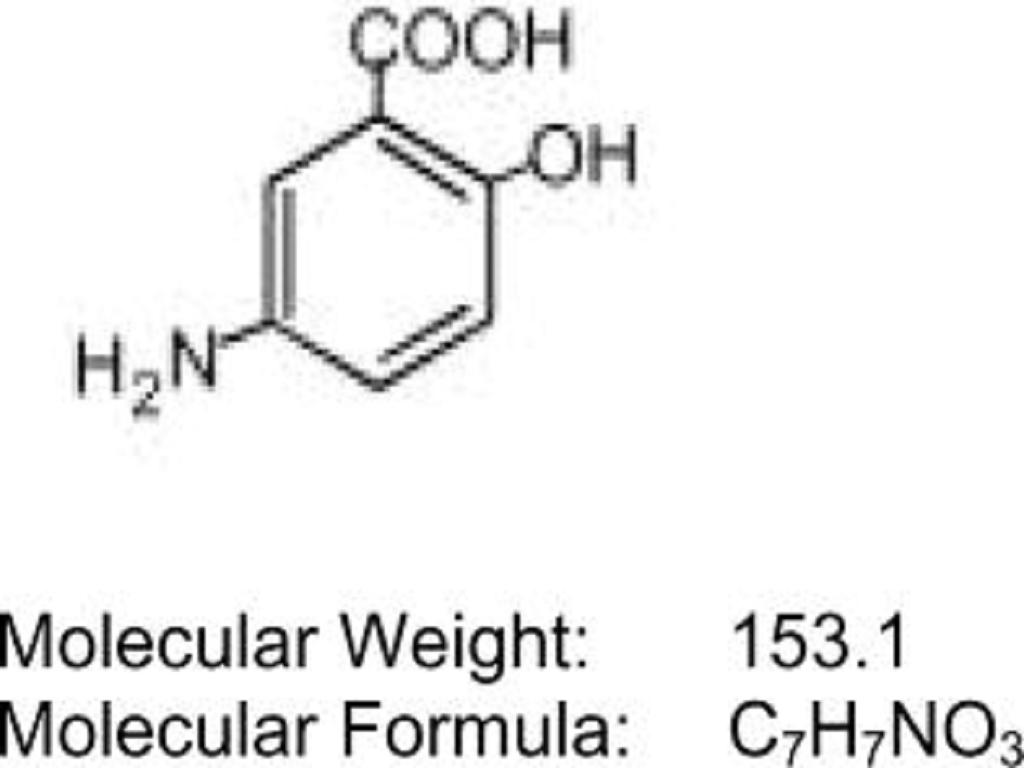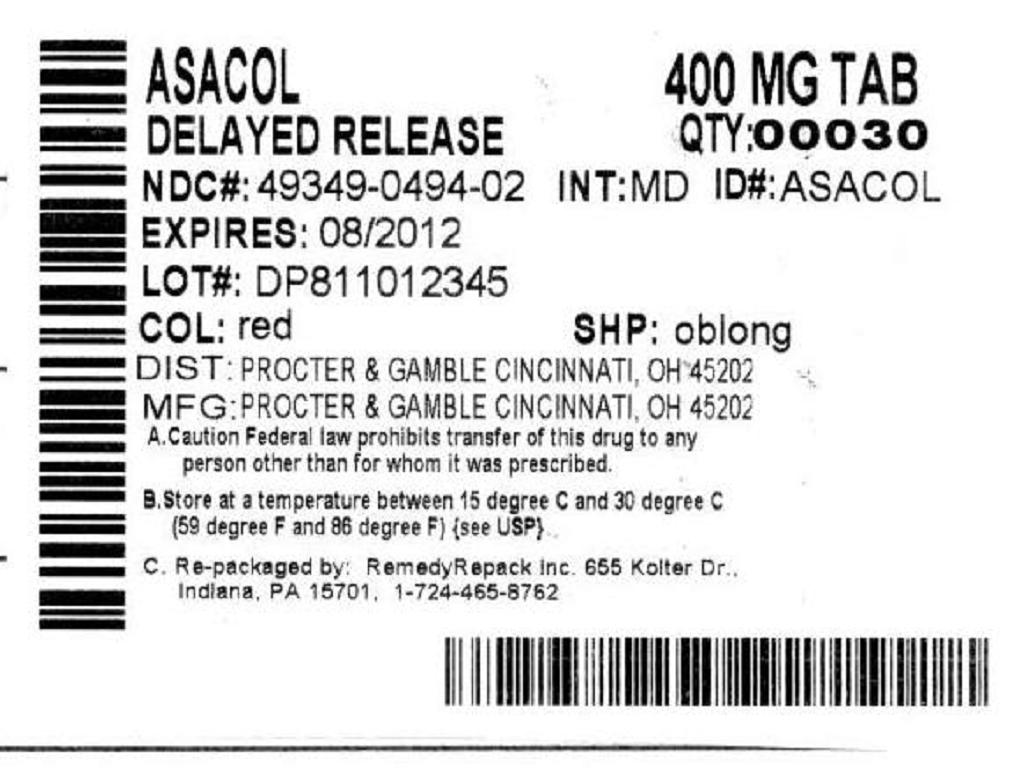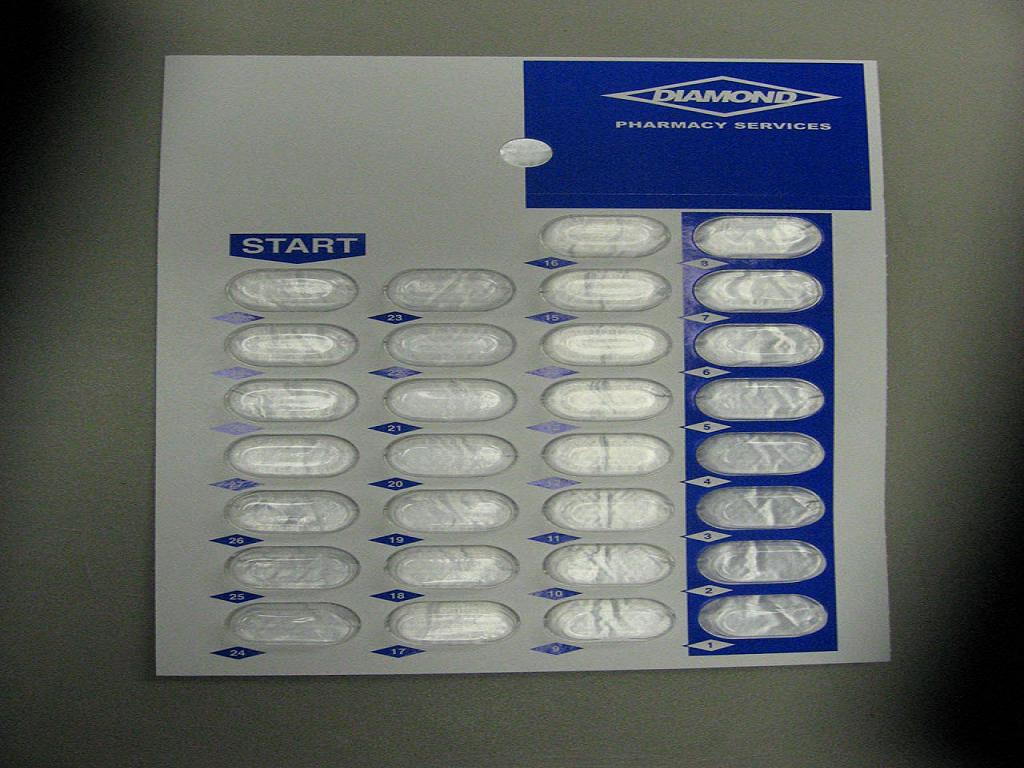ASACOL- mesalamine tablet
REMEDYREPACK INC.
----------
DESCRIPTION
Each Asacol delayed-release tablet for oral administration contains 400 mg of mesalamine, an anti-inflammatory drug. The Asacol delayed-release tablets are coated with acrylic based resin, Eudragit S (methacrylic acid copolymer B, NF), which dissolves at pH 7 or greater, releasing mesalamine in the terminal ileum and beyond for topical anti-inflammatory action in the colon. Mesalamine has the chemical name 5-amino-2-hydroxybenzoic acid; its structural formula is:

Inactive Ingredients: Each tablet contains colloidal silicon dioxide, dibutyl phthalate, edible black ink, iron oxide red, iron oxide yellow, lactose, magnesium stearate, methacrylic acid copolymer B (Eudragit S), polyethylene glycol, povidone, sodium starch glycolate, and talc.
CLINICAL PHARMACOLOGY
Mesalamine is thought to be the major therapeutically active part of the sulfasalazine molecule in the treatment of ulcerative colitis. Sulfasalazine is converted to equimolar amounts of sulfapyridine and mesalamine by bacterial action in the colon. The usual oral dose of sulfasalazine for active ulcerative colitis is 3 to 4 grams daily in divided doses, which provides 1.2 to 1.6 grams of mesalamine to the colon.
The mechanism of action of mesalamine (and sulfasalazine) is unknown, but appears to be topical rather than systemic. Mucosal production of arachidonic acid (AA) metabolites, both through the cyclooxygenase pathways, i.e., prostanoids, and through the lipoxygenase pathways, i.e., leukotrienes (LTs) and hydroxyeicosatetraenoic acids (HETEs), is increased in patients with chronic inflammatory bowel disease, and it is possible that mesalamine diminishes inflammation by blocking cyclooxygenase and inhibiting prostaglandin (PG) production in the colon.
PHARMACOKINETICS
Asacol tablets are coated with an acrylic-based resin that delays release of mesalamine until it reaches the terminal ileum and beyond. This has been demonstrated in human studies conducted with radiological and serum markers. Approximately 28% of the mesalamine in Asacol tablets is absorbed after oral ingestion, leaving the remainder available for topical action and excretion in the feces. Absorption of mesalamine is similar in fasted and fed subjects. The absorbed mesalamine is rapidly acetylated in the gut mucosal wall and by the liver. It is excreted mainly by the kidney as N-acetyl-5-aminosalicylic acid.
Mesalamine from orally administered Asacol tablets appears to be more extensively absorbed than the mesalamine released from sulfasalazine. Maximum plasma levels of mesalamine and N-acetyl-5-aminosalicylic acid following multiple Asacol doses are about 1.5 to 2 times higher than those following an equivalent dose of mesalamine in the form of sulfasalazine. Combined mesalamine and N-acetyl-5-aminosalicylic acid AUC's and urine drug dose recoveries following multiple doses of Asacol tablets are about 1.3 to 1.5 times higher than those following an equivalent dose of mesalamine in the form of sulfasalazine.
The tmax for mesalamine and its metabolite, N-acetyl-5-aminosalicylic acid, is usually delayed, reflecting the delayed release, and ranges from 4 to 12 hours. The half-lives of elimination (t1/2elm) for mesalamine and N-acetyl-5-aminosalicylic acid are usually about 12 hours, but are variable, ranging from 2 to 15 hours. There is a large intersubject variability in the plasma concentrations of mesalamine and N-acetyl-5-aminosalicylic acid and in their elimination half-lives following administration of Asacol tablets.
CLINICAL STUDIES
Mildly to moderately active ulcerative colitis:
Two placebo-controlled studies have demonstrated the efficacy of Asacol tablets in patients with mildly to moderately active ulcerative colitis. In one randomized, double-blind, multi-center trial of 158 patients,
Asacol
doses of 1.6 g/day and 2.4 g/day were compared to placebo. At the dose of 2.4 g/day,
Asacol
tablets reduced the disease activity, with 21 of 43 (49%)
Asacol
patients showing improvement in sigmoidoscopic appearance of the bowel compared to 12 of 44 (27%) placebo patients (p = 0.048). In addition, significantly more patients in the
Asacol
2.4 g/day group showed improvement in rectal bleeding and stool frequency. The 1.6 g/day dose did not produce consistent evidence of effectiveness.
In a second randomized, double-blind, placebo-controlled clinical trial of 6 weeks duration in 87 ulcerative colitis patients,
Asacol
tablets, at a dose of 4.8 g/day, gave sigmoidoscopic improvement in 28 of 38 (74%) patients compared to 10 of 38 (26%) placebo patients (p < 0.001). Also, more patients in the
Asacol
4.8 g/day group showed improvement in overall symptoms.
Maintenance of remission of ulcerative colitis:
A 6-month, randomized, double-blind, placebo-controlled, multi-center study involved 264 patients treated with
Asacol
0.8 g/day (n = 90), 1.6 g/day (n = 87), or placebo (n = 87). The proportion of patients treated with 0.8 g/day who maintained endoscopic remission was not statistically significant compared to placebo. In the intention to treat (ITT) analysis of all 174 patients treated with
Asacol
1.6 g/day or placebo,
Asacol
maintained endoscopic remission of ulcerative colitis in 61 of 87 (70.1%) of patients, compared to 42 of 87 (48.3%) of placebo recipients (p = 0.005).
A pooled efficacy analysis of 4 maintenance trials compared
Asacol
, at doses of 0.8 g/day to 2.8 g/day, with sulfasalazine, at doses of 2 g/day to 4 g/day (n = 200). Treatment success was 59 of 98 (59%) for
Asacol
and 70 of 102 (69%) for sulfasalazine, a non-significant difference.
Study to assess the effect on male fertility:
The effect of
Asacol
(mesalamine) on sulfasalazine-induced impairment of male fertility was examined in an open-label study. Nine patients (age < 40 years) with chronic ulcerative colitis in clinical remission on sulfasalazine 2 g/day to 3 g/day were crossed over to an equivalent
Asacol
dose (0.8 g/day to 1.2 g/day) for 3 months. Improvement in sperm count (p < 0.02) and morphology (p < 0.02) occurred in all cases. Improvement in sperm motility (p < 0.001) occurred in 8 of the 9 patients.
INDICATIONS & USAGE
Asacol
tablets are indicated for the treatment of mildly to moderately active ulcerative colitis and for the maintenance of remission of ulcerative colitis.
CONTRAINDICATIONS
Asacol
tablets are contraindicated in patients with hypersensitivity to salicylates or to any of the components of the
Asacol
tablet.
PRECAUTIONS
General:
Patients with pyloric stenosis may have prolonged gastric retention of
Asacol
tablets which could delay release of mesalamine in the colon.
Exacerbation of the symptoms of colitis has been reported in 3% of
Asacol
-treated patients in controlled clinical trials. This acute reaction, characterized by cramping, abdominal pain, bloody diarrhea, and occasionally by fever, headache, malaise, pruritus, rash, and conjunctivitis, has been reported after the initiation of
Asacol
tablets as well as other mesalamine products. Symptoms usually abate when
Asacol
tablets are discontinued.
Some patients who have experienced a hypersensitivity reaction to sulfasalazine may have a similar reaction to
Asacol
tablets or to other compounds which contain or are converted to mesalamine.
Renal:
Renal impairment, including minimal change nephropathy, acute and chronic interstitial nephritis, and, rarely, renal failure has been reported in patients taking
Asacol
tablets as well as other compounds which contain or are converted to mesalamine. In animal studies (rats, dogs), the kidney is the principal target organ for toxicity. At doses of approximately 750 mg/kg to 1000 mg/kg [15 to 20 times the administered recommended human dose (based on a 50 kg person) on a mg/kg basis and 3 to 4 times on a mg/m2 basis], mesalamine causes renal papillary necrosis. Therefore, caution should be exercised when using
Asacol
(or other compounds which contain or are converted to mesalamine or its metabolites) in patients with known renal dysfunction or history of renal disease. It is recommended that all patients have an evaluation of renal function prior to initiation of
Asacol
tablets and periodically while on
Asacol
therapy.
Use in Hepatic Impairment: There have been reports of hepatic failure in patients with pre-existing liver disease who have been administered mesalamine. Caution should be exercised when administering
Asacol
to patients with liver disease.
INFORMATION FOR PATIENTS
Patients should be instructed to swallow the
Asacol
tablets whole, taking care not to break cut, or chew the tablets, because the coating is an important part of the delayed-release formulation. In 2% to 3% of patients in clinical studies, intact or partially intact tablets have been reported in the stool. If this occurs repeatedly, patients should contact their physician.
Patients with ulcerative colitis should be made aware that ulcerative colitis rarely remits completely, and that the risk of relapse can be substantially reduced by continued administration of
Asacol
at a maintenance dosage.
CARCINOGENESIS & MUTAGENESIS & IMPAIRMENT OF FERTILITY
Dietary mesalamine was not carcinogenic in rats at doses as high as 480 mg/kg/day, or in mice at 2000 mg/kg/day. These doses are 2.4 and 5.1 times the maximum recommended human maintenance dose of
Asacol
of 1.6 g/day (32 mg/kg/day if 50 kg body weight assumed or 1184 mg/m2), respectively, based on body surface area. Mesalamine was negative in the Ames assay for mutagenesis, negative for induction of sister chromatid exchanges (SCE) and chromosomal aberrations in Chinese hamster ovary cells in vitro, and negative for induction of micronuclei (MN) in mouse bone marrow polychromatic erythrocytes. Mesalamine, at oral doses up to 480 mg/kg/day (about 1.6 times the recommended human treatment dose on a body surface area basis), was found to have no effect on fertility or reproductive performance of male and female rats.
PREGNANCY
Teratogenic Effects:
Pregnancy Category B: Reproduction studies have been performed in rats at oral doses up to 480 mg/kg/day (about 1.6 times the recommended human treatment dose on a body surface area basis) and rabbits at oral doses up to 480 mg/kg/day (about 3.2 times the recommended human treatment dose on a body surface area basis) and have revealed no evidence of impaired fertility or harm to the fetus due to mesalamine. There are, however, no adequate and well-controlled studies in pregnant women. Because animal reproduction studies are not always predictive of human response, this drug should be used during pregnancy only if clearly needed.
NURSING MOTHERS
Low concentrations of mesalamine and higher concentrations of its N-acetyl metabolite have been detected in human breast milk. While the clinical significance of this has not been determined, caution should be exercised when mesalamine is administered to a nursing woman.
PEDIATRIC USE
Safety and effectiveness of
Asacol
tablets in pediatric patients have not been established.
GERIATRIC USE
Clinical studies of
Asacol
did not include sufficient numbers of subjects aged 65 and over to determine whether they respond differently from younger subjects. Other reported clinical experience has not identified differences in responses between the elderly and younger patients. In general, the greater frequency of decreased hepatic, renal, or cardiac function, and of concomitant disease or other drug therapy in elderly patients should be considered when prescribing
Asacol.
Reports from uncontrolled clinical studies and post-marketing reporting systems suggest a higher incidence of blood dyscrasias, i.e., agranulocytosis, neutropenia, pancytopenia, in subjects receiving
Asacol
who are 65 years or older. Caution should be taken to closely monitor blood cell counts during drug therapy.
This drug is known to be substantially excreted by the kidney, and the risk of toxic reactions to this drug may be greater in patients with impaired renal function. Because elderly patients are more likely to have decreased renal function, care should be taken when prescribing this drug therapy. As stated in the
PRECAUTIONS
section, it is recommended that all patients have an evaluation of renal function prior to initiation of
Asacol
tablets and periodically while on
Asacol
therapy.
ADVERSE REACTIONS
Asacol
tablets have been evaluated in 3685 inflammatory bowel disease patients (most patients with ulcerative colitis) in controlled and open-label studies. Adverse events seen in clinical trials with
Asacol
tablets have generally been mild and reversible. Adverse events presented in the following sections may occur regardless of length of therapy and similar events have been reported in short- and long-term studies and in the post-marketing setting.
In two short-term (6 weeks) placebo-controlled clinical studies involving 245 patients, 155 of whom were randomized to
Asacol
tablets, five (3.2%) of the
Asacol
patients discontinued
Asacol
Adverse events occurring in
Asacol
-treated patients at a frequency of 2% or greater in the two short-term, double-blind, placebo-controlled trials mentioned above are listed in
Table 1
below. Overall, the incidence of adverse events seen with
Asacol
tablets was similar to placebo.
Table 1 Frequency (%) of Common Adverse Events Reported in Ulcerative Colitis Patients Treated with Asacol Tablets or Placebo in Short-Term (6-Week) Double-Blind Controlled Studies
Percent of Patients with Adverse EventsPlaceboAsacol tabletsEvent(n = 87)(n = 152)Headache3635Abdominal pain1418Eructation1516Pain814Nausea1513Pharyngitis911Dizziness88Asthenia157Diarrhea97Back pain57Fever86Rash36Dyspepsia16Rhinitis55Arthralgia35Hypertonia35Vomiting25Constipation15Flatulence73Dysmenorrhea33Chest pain23Chills23Flu syndrome23Peripheral edema23Myalgia13Sweating13Colitis exacerbation03Pruritus03Acne12Increased cough12Malaise12Arthritis02Conjunctivitis02Insomnia02Of these adverse events, only rash showed a consistently higher frequency with increasing
Asacol
dose in these studies.
In a 6-month placebo-controlled maintenance trial involving 264 patients, 177 of whom were randomized to
Asacol
tablets, six (3.4%) of the
Asacol
In the 6-month placebo-controlled maintenance trial, the incidence of adverse events seen with
Asacol
tablets was similar to that seen with placebo. In addition to events listed in
Table 1
, the following adverse events occurred in
Asacol-
treated patients at a frequency of 2% or greater in this study: abdominal enlargement, anxiety, bronchitis, ear disorder, ear pain, gastroenteritis, gastrointestinal hemorrhage, infection, joint disorder, migraine, nervousness, paresthesia, rectal disorder, rectal hemorrhage, sinusitis, stool abnormalities, tenesmus, urinary frequency, vasodilation, and vision abnormalities.
In 3342 patients in uncontrolled clinical studies, the following adverse events occurred at a frequency of 5% or greater and appeared to increase in frequency with increasing dose: asthenia, fever, flu syndrome, pain, abdominal pain, back pain, flatulence, gastrointestinal bleeding, arthralgia, and rhinitis.
In addition to the adverse events listed above, the following events have been reported in clinical studies, literature reports, and postmarketing use of products which contain (or have been metabolized to) mesalamine. Because many of these events were reported voluntarily from a population of unknown size, estimates of frequency cannot be made. These events have been chosen for inclusion due to their seriousness or potential causal connection to mesalamine:
Body as a Whole:
Neck pain, facial edema, edema, lupus-like syndrome, drug fever (rare).
Cardiovascular:
Pericarditis (rare), myocarditis (rare).
Gastrointestinal:
Anorexia, pancreatitis, gastritis, increased appetite, cholecystitis, dry mouth, oral ulcers, perforated peptic ulcer (rare), bloody diarrhea. There have been rare reports of hepatotoxicity including, jaundice, cholestatic jaundice, hepatitis, and possible hepatocellular damage including liver necrosis and liver failure. Some of these cases were fatal. Asymptomatic elevations of liver enzymes which usually resolve during continued use or with discontinuation of the drug have also been reported. One case of Kawasaki-like syndrome which included changes in liver enzymes was also reported.
Hematologic:
Agranulocytosis (rare), aplastic anemia (rare), thrombocytopenia, eosinophilia, leukopenia, anemia, lymphadenopathy.
Musculoskeletal:
Gout.
Nervous:
Depression, somnolence, emotional lability, hyperesthesia, vertigo, confusion, tremor, peripheral neuropathy (rare), transverse myelitis (rare), Guillain-Barrsyndrome (rare).
Respiratory/Pulmonary:
Eosinophilic pneumonia, interstitial pneumonitis, asthma exacerbation, pleuritis.
Skin:
Alopecia, psoriasis (rare), pyoderma gangrenosum (rare), dry skin, erythema nodosum, urticaria.
Special Senses:
Eye pain, taste perversion, blurred vision, tinnitus.
Urogenital:
Renal Failure (rare), interstitial nephritis, minimal change nephropathy (See also
Renal subsection in PRECAUTIONS
). Dysuria, urinary urgency, hematuria, epididymitis, menorrhagia.
Laboratory Abnormalities:
Elevated AST (SGOT) or ALT (SGPT), elevated alkaline phosphatase, elevated GGT, elevated LDH, elevated bilirubin, elevated serum creatinine and BUN.
DRUG ABUSE AND DEPENDENCE
Abuse: None reported.
Dependency: Drug dependence has not been reported with chronic administration of mesalamine.
OVERDOSAGE
Two cases of pediatric overdosage have been reported. A 3-year-old male who ingested 2 grams of
Asacol
Asacol
Asacol
tablets resulted in renal papillary necrosis but were not fatal. This was approximately 12.5 times the recommended human dose (based on a dose of 2.4 g/day in a 50 kg person). Single oral doses of uncoated mesalamine in mice and rats of 5000 mg/kg and 4595 mg/kg, respectively, or of 3000 mg/kg in cynomolgus monkeys, caused significant lethality.
DOSAGE & ADMINISTRATION
For the treatment of mildly to moderately active ulcerative colitis:
The usual dosage in adults is two 400-mg tablets to be taken three times a day for a total daily dose of 2.4 grams for a duration of 6 weeks.
For the maintenance of remission of ulcerative colitis:
The recommended dosage in adults is 1.6 grams daily, in divided doses. Treatment duration in the prospective, well-controlled trial was 6 months.
Two Asacol 400 mg tablets have not been shown to be bioequivalent to one Asacol HD 800 mg tablet.
HOW SUPPLIED
Asacol tablets are available as red-brown, capsule-shaped tablets containing 400 mg mesalamine and imprintedAsacol NEin black.
NDC 0149-0752-15 Bottle of 180
| ASACOL
mesalamine tablet |
||||||||||||||||||||||
|
||||||||||||||||||||||
|
||||||||||||||||||||||
|
||||||||||||||||||||||
|
||||||||||||||||||||||
|
||||||||||||||||||||||
|
||||||||||||||||||||||
| Labeler - REMEDYREPACK INC. (829572556) |

